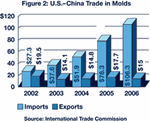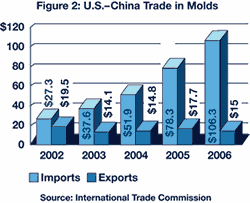How Shops Share Design Data with IP Protection
What to look for in your software to overcome the technical hurdles, cost factors and IP risk around sharing design data.
More mold work going overseas may bring manufacturing cost savings, but it opens up the possibility of intellectual property (IP) being compromised. Fortunately there are ways to protect IP—some more efficient than others. This article will discuss how to best protect your shop’s IP.
Sharing CAD data with partners overseas can put intellectual property at risk. IP theft is costing everyone in the manufacturing sector lots of money. It is estimated to be a $12 to $16 billion problem in the automotive sector alone.
Most companies that wish to protect IP will strive to provide the minimal amount of information their suppliers need. This is typically accomplished by three mechanisms: file encryption, secure access via a product data management (PDM) servers, or manually de-featuring the product geometry with CAD software where suppliers are provided an attenuated (simplified) model.
File encryption and secure check-in/check-out access via PDM servers provide blunt tools to protect data. They nearly guarantee that the authorized party will be the one that uses the data—at least initially. The problems with these methods are that the supplier may still inadvertently mishandle the data, and these methods also can prevent the correct data from getting into the correct hands.
Providing attenuated product geometry can be a better approach, as it provides data the supplier needs to be effective, but limits the intrinsic IP content of the geometry. For mold work, such de-featured geometry may confer additional benefits, as fully featured geometry can be inappropriate for mold production.
Ideally, a mold designer will use a software system to perform modifications to the geometry automatically. Such systems are more cost-effective as they save time and improve consistency, especially with product designs that are under frequent revision.
Solutions exist that allow CAD geometry to be transformed automatically and delivered to the intended location on a network. Such solutions allow the user to build a recipe that describes the import of native CAD geometry, the transformation steps to be performed on the geometry (including steps that will remove IP such as removing holes in a product design), and the intended formats and locations of the resultant CAD geometry output files—in high precision B-Reps or lower precision polygonal models. Here is what to look for in a CAD data software solution that protects IP.
Automatic De-Featuring
Automatic de-featuring saves a great deal of time. When performing defeaturing manually, the user typically performs a series of edits with CAD software. This can lead to errors. Automatic de-featuring of the CAD geometry provides more consistent results.
Versatility with Major CAD Formats
Make sure to purchase a solution that works with the major CAD software formats. Before purchasing a solution for repurposing CAD geometry, find out which software formats are supported—both input and output. In particular, make certain that high-precision B-rep output is supported in the appropriate formats.
User-Friendliness
It is important to purchase a solution that is easy to use. Any person in the shop that is working in the CAD/CAM department should be able to learn the CAD data software solution package quickly. There should be minimal costs associated with training and basic proficiency.
In summary, the proper CAD data transformation solution should create an automation path for transforming CAD geometry quickly and delivering the data to a moldmaker’s partners and suppliers while protecting that company’s IP.
Related Content
Making Quick and Easy Kaizen Work for Your Shop
Within each person is unlimited creative potential to improve shop operations.
Read MoreThe Role of Social Media in Manufacturing
Charles Daniels CFO of Wepco Plastics shares insights on the role of social media in manufacturing, how to improve the “business” side of a small mold shop and continually developing culture.
Read MoreThink Safety: Eliminate Hazards Throughout the Shop
The tooling community is taking advantage of new products for safer mold shops and molding facilities.
Read MoreMMT Chats: Solving Schedule and Capacity Challenges With ERP
For this MMT Chat, my guests hail from Omega Tool of Menomonee Falls, Wisconsin, who share their journey with using enterprise resource planning (ERP)—and their people—to solve their schedule and capacity load monitoring challenges.
Read MoreRead Next
Trade Policy Developments Affecting the U.S. Moldmaking Industry
Mold manufacturers must become aware of the trade policy developments affecting their industry and reach out to their elected officials, sharing with them their trade-related interests and concerns.
Read MoreHow to Use Continuing Education to Remain Competitive in Moldmaking
Continued training helps moldmakers make tooling decisions and properly use the latest cutting tool to efficiently machine high-quality molds.
Read MoreReasons to Use Fiber Lasers for Mold Cleaning
Fiber lasers offer a simplicity, speed, control and portability, minimizing mold cleaning risks.
Read More





















